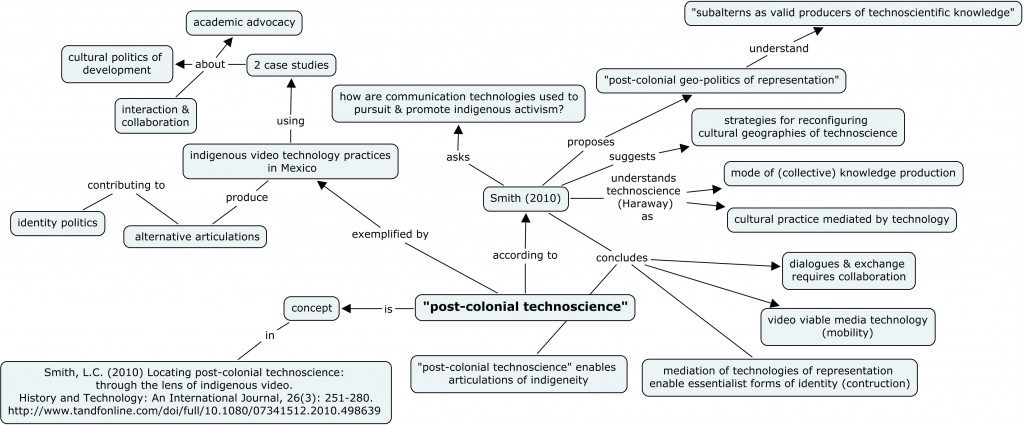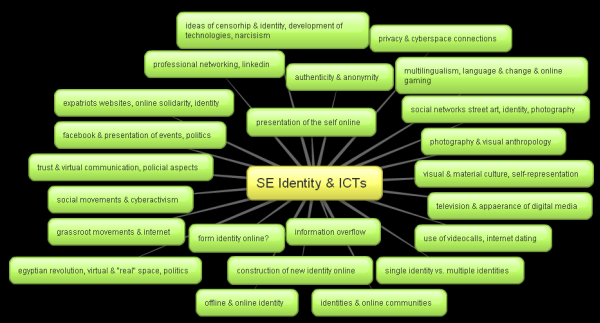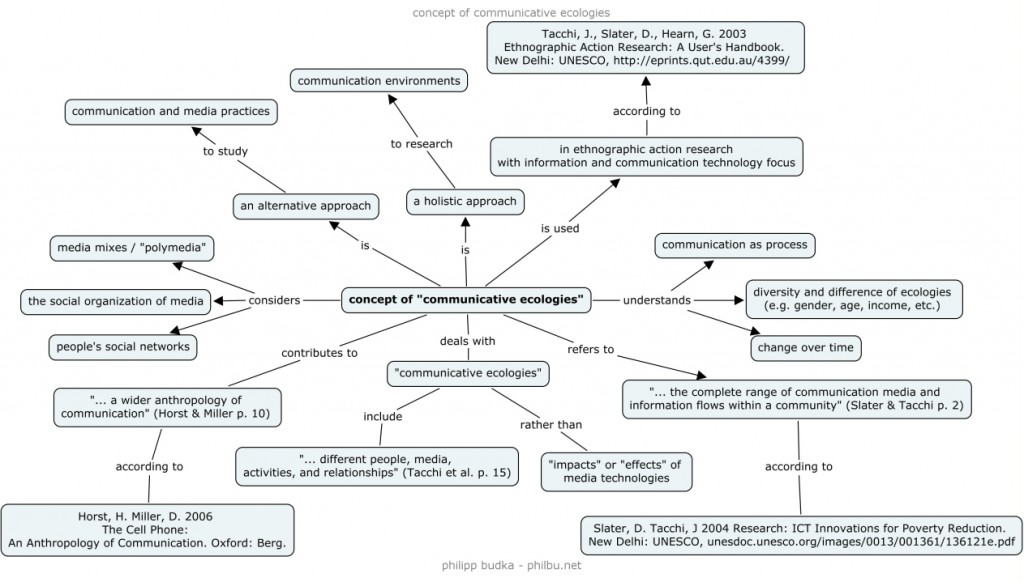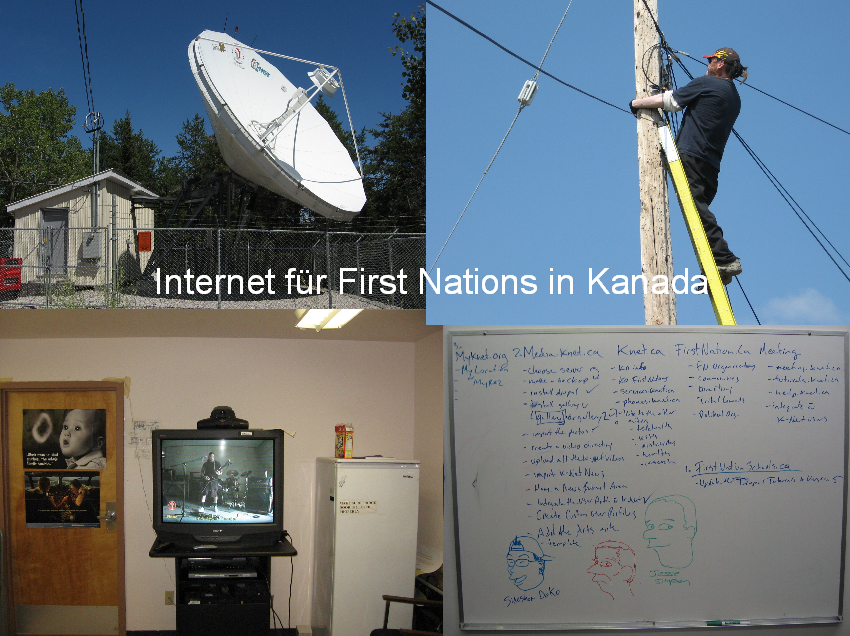This map visualizes the concept of “post-colonial technoscience” discussed by Smith, L. C. 2010. Locating post-colonial technoscience: through the lens of indigenous video. History and Technology: An International Journal, 26(3): 251-280. It was done by using the free CMap Tools (click to enlarge).
Posts categoriezed as media anthropology
Review: Unmasking deep democracy: An anthropology of indigenous media in Canada
Budka, P. 2015. Review of Unmasking deep democracy: An anthropology of indigenous media in Canada, by S. B. Hafsteinsson. Aarhus: Intervention Press, 2013. Social Anthropology, 23/2: 240-242.
In the book’s introduction Sigurjon Baldur Hafsteinsson declares that the anthropological study which resulted in Unmasking Deep Democracy will, on the one hand, challenge the anthropology of visual communication and, on the other hand, contribute to the sub-discipline’s arguments. The anthropology of visual communication, like the anthropology of media, focuses in particular on the relational aspects and characteristics of (visual) media, such as television. This volume is about indigenous television in the Canadian context. By analysing communicative and journalistic practices of the Aboriginal Peoples Television Network (APTN) it aims for gaining an insight into the sociocultural agency of indigeneity and its (media) politics.
Continue reading Review: Unmasking deep democracy: An anthropology of indigenous media in Canada
Seminar: Indigenous Media 2015
Seminar “Indigenous Media” by Philipp Budka
MA Program in Visual & Media Anthropology,
Freie Universität Berlin
Course Description
In this course students get an introduction to indigenous media technologies. In ten seminar units selected questions, issues, and problems are discussed: How do indigenous people produce, distribute, and utilize audiovisual media? How has ethnographic and anthropological film making changed? What role do politics, power, globalization, and (post-)colonialism play in the production and use of indigenous media? How do indigenous people utilize media to construct and negotiate their individual and collective identities? How are indigenous cultures and languages represented through media? And how do indigenous people appropriate and (co-)develop digital technologies in times of increasing globalization?
Review: Cyberidentities at war: The Moluccan conflict on the Internet
Budka, P. 2015. Review of Bräuchler, B. Cyberidentities at war: The Moluccan conflict on the Internet. New York & Oxford: Berghahn, 2013. American Anthropologist, 117/1: 179-180.
Birgit Bräuchler’s book Cyberidentities at War was originally published in German in 2005. It is the result of her dissertation research on the Moluccan conflict and how it took place in cyberspace—the social space constituted by Internet-related practices. The English edition of this volume not only brings one of the few long-term ethnographic accounts of an online conflict to an international audience but also includes a new epilogue that briefly discusses what happened to the actors analyzed in the book and current developments in anthropological Internet research, particularly in respect to social movements and religions. In the early 2000s, a detailed anthropological inquiry into conflicts in relation to Internet technologies was still missing. By providing such an anthropological account and by conducting online ethnographic research, Bräuchler broke new ground and contributed to the then-emerging field of cyberanthropology.
Continue reading Review: Cyberidentities at war: The Moluccan conflict on the Internet
Paper: Indigenous futures and digital infrastructures
Budka, P. 2014. Indigenous futures and digital infrastructures: How First Nation communities connect themselves in Northwestern Ontario. Paper at “13th Biennial Conference of the European Association of Social Anthropologists (EASA)”, Tallinn, Estonia: Tallinn University, 31 July – 3 August.
Introduction
“Now […] if the Aboriginal People could […], retain their tradition, take the technology and go that way in the future. That would be good.”
(Community Development Coordinator and Educational Director, Bearskin Lake First Nation, 2007)
For my first field trip to Northwestern Ontario in 2006, I decided to take the train from Toronto to Sioux Lookout instead of flying. This ride with “the Canadian”, which connects Toronto and Vancouver, took me about 26 hours and demonstrated very vividly the vastness of Ontario. At some point, I could not believe that I have been spending more than an entire day on a train without even leaving the province. But finally I arrived at Sioux Lookout, Northwestern Ontario’s transportation hub, where I would be working with the Keewaytinook Okimakanak Kuhkenah Network (KO-KNET), one of the world’s leading indigenous internet organization.
After my first day at the office, KO-KNET’s coordinator told me that he wants to show me something. So we jumped in his car and drove to the outskirts of the town where he stopped in front of a big satellite dish. Only through this dish, he explained, the remote First Nation communities in the North can be connected to the internet. I was pretty impressed, but had no concrete idea how this really works. So while the satellite dish was physically visible to me, the underlying infrastructure was not. During my stay, I learned more about the technical aspects of internet networks and connectivity, about hubs, switches and cables, and about towers and loops. And I learned that internet via satellite might look impressive, but is actually the last resort and the most expensive way to establish internet connectivity. I also began to realize how important organizational partnerships and collaborative projects are and what important role social relationships across institutional boundaries play. In short: I learned about the infrastructure which is actually necessary to finance, provide and maintain internet access and use. Infrastructure, KO-KNET’s coordinator told me “really defines what you can do and what you can’t do” (KO-KNET coordinator 2007). And this has fundamental consequences for the futures of the region’s indigenous people.
Within this paper I am going to discuss digital infrastructures and technologies in the geographical and sociocultural contexts of indigenous Northwestern Ontario. By introducing the case of KO-KNET I analyse (1) how internet infrastructures act as facilitators of social relationships and (2) how First Nations people actively make their (digital) futures by taking control over the creation, distribution and uses of information and communication technologies (ICT), such as broadband internet. This study is part of a digital media anthropology project that was conducted for five years, including ethnographic fieldwork in Northwestern Ontario and in online environments.
In media and visual anthropology, anthropologists are, among other things of course, interested in how indigenous, disfranchised and marginalized people have started to talk back to structures of power that neglect their political, cultural and economic needs and interests by producing and distributing their own media technologies (e.g., Ginsburg 1991, 2002b, Michaels 1994, Prins 2002, Turner 1992, 2002). To “underscore the sense of both political agency and cultural intervention that people bring to these efforts”, Faye Ginsburg (2002a: 8, 1997) refers to these media practices as “cultural activism”. “Indigenized” media technologies are providing indigenous people with possibilities to make their voices heard, to network and connect, to distribute information, to revitalize culture and language, and to become politically engaged and active (Ginsburg 2002a, 2002b). Particularly digital media technologies offer a lot of these possibilities to marginalized people (e.g., Landzelius 2006a).
Paper: Von „Cyber Anthropologie“ zu „Digitaler Anthropologie“: kultur- und sozialanthropologische Beiträge zur Erforschung digitaler Medientechnologien.
Budka. P. 2014. Von „Cyber Anthropologie“ zu „Digitaler Anthropologie“: kultur- und sozialanthropologische Beiträge zur Erforschung digitaler Medientechnologien. Vortrag im Rahmen der Ringvorlesung: „Rituale, Medien, Bewusstsein – in Memoriam Manfred Kremser“, 9. Januar 2014.
Einleitung
Dieser Vortrag wirft einen Blick auf die kultur- und sozialanthropologische Erforschung digitaler Medientechnologien wie Internet, Soziale Online-Netzwerke und mobile Kommunikationstechnologien. Dabei werden die Grundzüge des Forschungsfeldes der „Cyber Anthropologie“ – besonders im Bezug zum Wiener Institut für Kultur- und Sozialanthropologie – ebenso vorgestellt wie die rezente Entwicklung einer „Digitalen Anthropologie“. Die gemeinsame, übergeordnete Frage dieser kultur- und sozialanthropologischen Projekte lautet: „Was bedeutet Menschsein in einer (zunehmend) digitalen Welt?“. Fallbeispiele aus der ethnographischen Forschungspraxis behandeln konkrete Aspekte des „digitalen Menschseins“ und runden die theoretische Diskussion ab.
Medienanthropologie und die technische Mediatisierung von Kommunikation
In der Kultur- und Sozialanthropologie lässt sich die Forschung zu Medientechnologien grundsätzlich als Forschung zu menschlicher Kommunikation, die von Technologien mediatisiert wird, verstehen. Diese Mediatisierung von Kommunikation ist für die Kultur- und Sozialanthropologie besonders hinsichtlich ihrer Einbettung in soziokulturelle und historische Prozesse und Kontexte interessant: „The key questions for the anthropologist are how these technologies operate to mediate human communication, and how such mediation is embedded in broader social and historical processes“ (Peterson 2003: 5).
In der Medienanthropologie geht es um die Mediatisierung von Kommunikation in unterschiedlichen soziokulturellen Kontexten und unter spezifischen historischen, politischen und ökonomischen Bedingungen.
In der Kultur- und Sozialanthropologie werden Medien nicht auf ihre Inhalte oder Botschaften reduziert. Im Versuch ein möglichst ganzheitliches Bild von Medienphänomenen zu erlangen, werden Kontexte und Bedingungen unter denen Medien produziert, verteilt und genutzt werden ebenso analysiert wie die technischen Aspekte von Medien. Medien beinhalten immer auch Technologien, die die Mediatisierung von Kommunikation erst ermöglichen. Es macht also Sinn nicht nur von Medien sondern von Medientechnologien zu sprechen.
Über Medientechnologien entwickeln Menschen neue Beziehungen zu Zeit und Raum sowie zu Körper und Wahrnehmung. Und diese Verhältnisse verändern sich aufgrund medientechnologischer Entwicklungen permanent. Die „greifbare“ Materialität von Medientechnologien und die damit verbundenen phänomenologischen Erfahrungen sind also wesentlicher Gegenstand medienethnographischer und medienanthropologischer Forschung (vgl. Ginsburg et al. 2002: 21).
Wichtigste methodische Herangehensweise, um Medienphänomene zu erfassen, ist für die Medienanthropologie, wie für die Kultur- und Sozialanthropologie im Allgemeinen, die ethnographische Feldforschung. Diese methodische Strategie zur empirischen Datenerhebung passt sich dabei sowohl dem Feld als auch den soziokulturellen Handlungsräumen der Menschen an (vgl. z.B. Kremser 1998, Marcus 1998) und kann sich also nicht allein auf Inhalte und deren Rezeption beschränken. Sie muss auch die physischen und sensorischen Dimensionen von Medientechnologien miteinbeziehen, weil über diese soziale Beziehungen hergestellt werden können.
Technologie im soziokulturellen Kontext
Seit den 1950er Jahren untersuchen Kultur- und SozialanthropologInnen neue und „moderne“ Technologien und wie diese vor allem in „nicht-westlichen“ Gemeinschaften verwendet und angeeignet werden (vgl. z.B. Beck 2001, Godelier 1971, Pfaffenberger 1992, Sharp 1952). Doch wie unter anderem Arturo Escobar (1994) meint, ist es schwierig diese Forschungsansätze und -befunde auf hochkomplexe technische Umgebungen in „modernen“ Gesellschaften zu übertragen. Aus kultur- und sozialanthropologischer Perspektive bedeutet diese Transferschwierigkeit weder eine Hierarchisierung von soziotechnischen Systemen und damit verbunden von Gesellschaften, noch bedeutet dies eine Abwertung „nicht-moderner“ oder „traditioneller“ soziotechnischer Systeme. All diese Systeme – vom Töpfern in Indien bis zum Programmieren von Software in Kalifornien – sind hochkomplex und heterogen.
Es besteht allerdings dringender Bedarf an theoretischen Zugängen und weiteren empirischen Befunden, die zum Verständnis soziotechnischer Systeme in „modernen“ Gesellschaften beitragen. So befasst sich auch die Kultur- und Sozialanthropologie zunehmend mit soziotechnischen Systemen in zeitgenössischen Gesellschaften (vgl. z.B. Rabinow 2008, Rabinow & Marcus 2008) – vor allem auch, weil immer wieder Fragen auftauchen, die scheinbar nur von der Kultur- und Sozialanthropologie beantwortet werden können, etwa nach der soziokulturellen und soziokulturell unterschiedlichen Bedeutung von Technologien (vgl. Pfaffenberger 1988, 1992).
Die Kultur- und Sozialanthropologie versucht zu verstehen, wie Technologie – beispielsweise in Form materieller Kultur oder als soziotechnisches System – (kulturell) konstruiert und (sozial) verwendet, genutzt und angeeignet wird. Ähnliche Ziele verfolgen auch Wissenschaftsforschung, Science and Technology Studies und sozialwissenschaftliche Technikforschung (vgl. z.B. Eglash 2006). Die Entwicklung und der Aufschwung digitaler (Medien)Technologien führen zu einer weiteren Differenzierung dieses Forschungsbereichs und zur Etablierung neuer Schwerpunkte.
Article: Digitale Medientechnologien aus kultur- und sozialanthropologischer Perspektive
Budka, P. 2013. Digitale Medientechnologien aus kultur- und sozialanthropologischer Perspektive: Überlegungen zu Technologie als materielle Kultur und Fetisch (Digital media technologies from an anthropological perspective: Reflections on technology as material culture and fetish). Medien und Zeit, 28, 1/2013: 22-34.
Abstract
Dieser Aufsatz blickt auf digitale Medientechnologien aus Perspektive der Kultur- und Sozialanthropologie. In einem wissenschaftstheoretischen und historischen Abriss werden einerseits Eckpunkte in der Entwicklung relevanter Forschungsfelder, wie die Anthropologie und Ethnographie der Medientechnologien, die Digitale Anthropologie sowie die Anthropologie der Cyberkultur behandelt. Andererseits werden zwei Fallbeispiele aus der ethnographischen Forschungspraxis vorgestellt, die digitale Technologien als materielle Kultur verstehen. Technologie als materielle Kultur erlaubt es die Materialität und die Normativität von Technologien ebenso zu fassen wie deren alltägliche Aneignung in wandelnden soziokulturellen, politischen und ökonomischen Kontexten. Der Aufsatz schließt mit einer Diskussion der Fetischisierung von Technologien, deren Bedeutung und Zusammenhänge.
Word cloud on identity, sociality, communality & digital media technologies
Word cloud of the student projects in the seminar “Identity, sociality & communality in times of digital media technologies” at the Department of Social and Cultural Anthropology, University of Vienna.
Seminar research projects
In the seminar “Identity, sociality & communality in times of digital media technologies” at the Department of Social and Cultural Anthropology, University of Vienna, students work in research teams on aspects of privacy, gaming, movements, participation, solidarity and visual culture.
Seminar: Identity, sociality and communality in times of digital media technologies
In the winter term 2012/2013, I am teaching a seminar on “Identity, sociality and communality in times of digital media technologies” at the Department of Social and Cultural Anthropology, University of Vienna. Students in this course learn about and to work with different forms of identity construction and processes of sociality and communality, which have been made possible through digital media technologies, such as the internet. Students get a brief overview about identity concepts and the possibility to deploy them within empirical research projects.
Find more information about this seminar here: http://www.philbu.net/courses.html
Concept map: Communicative ecologies
This map visualizes the concept of “communicative ecologies” as introduced by Tacchi, J., Slater, D., Hearn, G. 2003. Ethnographic Action Research: A User’s Handbook. New Delhi: UNESCO, http://eprints.qut.edu.au/4399/. It was done by using the free CMap Tools (click to enlarge).
Article: “We were on the outside looking in”: MyKnet.org – A First Nations Online Social Environment in Northern Ontario
Bell, B., Budka, P., Fiser, A. 2012. “We were on the outside looking in”: MyKnet.org – A First Nations online social environment in northern Ontario. In A. Clement, M. Gurstein, G. Longford, M. Moll & L. R. Shade (Eds.), Connecting Canadians: Investigations in Community Informatics (pp. 237-254). Edmonton: Athabasca University Press.
“In 2000, one of Canada’s leading Aboriginal community networks, the Kuh-ke-nah Network, or K-Net, was on the verge of expanding into broadband services. (For more on K-Net, see chapter 14.) K-Net’s management organization, Keewaytinook Okimakanak Tribal Council, had acquired funding and resources to become one of Industry Canada’s Smart Communities demonstration projects. Among the innovative services that K-Net introduced at the time was MyKnet.org, a system of personal home pages intended for remote First Nations users in a region of Northern Ontario where numerous communities have lived without adequate residential telecom service well into the millennium (Fiser, Clement, and Walmark 2006; Ramírez et al. 2003). Shortly thereafter, and through K-Net’s community-based Internet infrastructure, this free-of-charge, free-of-advertising, locally supported, online social environment grew from its core constituency of remote First Nations communities to host over 30,000 registered user accounts (of which approximately 20,000 represent active home pages). …”
free chapter download: http://www.aupress.ca/index.php/books/120193
Vortrag: IKT als Werkzeuge zur Reduktion erzwungener Mobilität
Vortrag im Rahmen der 7. Tage der Kultur- und Sozialanthropologie: “Informations- und Kommunikationstechnologien (IKT) als Werkzeuge zur Reduktion erzwungener Mobilität” (PDF)
Aus dem Inhalt:
- Indigene in Kanada & im Nordwestlichen Ontario
- Sitation von First Nations im Nordwestlichen Ontario
- Indigene IKT im Nordwestlichen Ontario: KO-KNET
- Reduktion erzwungener Mobilität durch IKT
- IKT-Anwendungspraktiken: Isolation vs. Sozialität
- Indigene IKT: Ergebnisse aktueller Studien
Indigene IKT: Ergebnisse aktueller Studien:
- IKT-Praktiken beeinflussen …
a) (kulturelle) Identitätskonstruktion & -verhandlung
b) (soziale) Vergemeinschaftungsformen & -prozesse
c) Kommunikationspraktiken
- Entscheidend sind …
a) Kontrolle von & Bezug zu IKT
b) Soziokulturelle, geographische & politische Kontexte/Rahmenbedingungen/Möglichkeiten
Vortrag: Indigene Medientechnologien
Gastvortrag im Rahmen der Vorlesung “Einführung in die Kultur- und Sozialanthropologie” (Sommersemester 2012, Leitung: Elke Mader): “Indigene Medientechnologien – Produktion & Anwendungspraktiken aus medienanthropologischer Perspektive“: Teil 1 / Teil 2 (PDF)
Aus dem Inhalt:
- Medientechnologien aus kultur- und sozialanthropologischer & ethnographischer Perspektive
- Indigene Medien:
Indigene?
Indigene IKT: „outreach“ Praktiken z.B. EZLN in Mexiko, „inreach“ Praktiken: z.B. KO-NET in Kanada - Indigene Medientechnologieproduktion: Beispiel „Internet für First Nations in Kanada“
- Indigene Medienanwendungspraktiken: Beispiel „MyKnet.org: Social Networking für First Nations in Kanada“ – Identitätskonstruktion, Vergemeinschaftungsformen, ethnographische Felderforschung
Article: How “real life” issues affect the social life of online networked communities
Budka, Philipp. 2008. How “real life” issues affect the social life of online networked communities. In C. Trupp & P. Budka (Eds.), Austrian Studies in Social Anthropology – Sondernummer KSA-Tage 2007 (Workshop Medien und Film), June 2008, 50-61.
Online: http://www.univie.ac.at/alumni.ethnologie/journal/abstract/budka.html
Abstract
Speaking of “the internet”, one often forgets that this is not a monolithic media technology, but a whole range of applications embedded in the life of people practicing these technologies. This paper explores on the one hand the social life of a publicly accessible mailing list that connects various indigenous and non-indigenous persons to form a global electronic network. On the other hand, it analyses a Usenet newsgroup, which is dedicated to the socio-cultural life in Austria. With the help of two cyberanthropological case studies the interconnections between “real life” or offline issues and “virtual” or online lives on mailing lists and newsgroups is demonstrated. The paper intends to show that “virtual life” never can be separated from “real life” and its issues.




